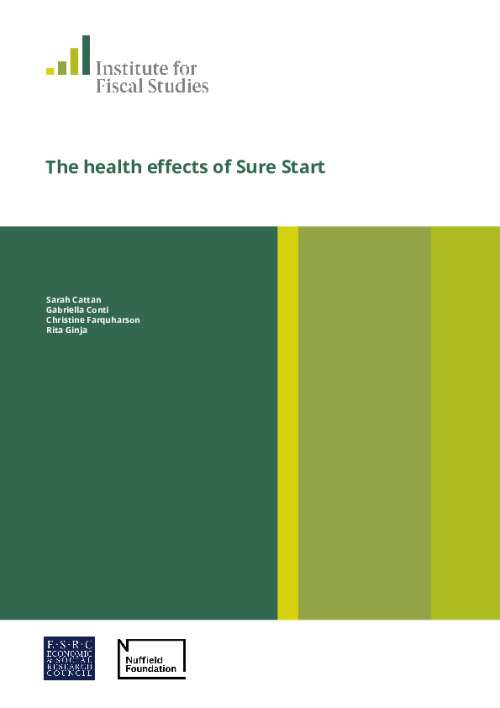New evaluation finds Sure Start had major health benefits for children in poorer neighbourhoods
Sure Start has had a turbulent history. The programme was first introduced in 1999 as Sure Start Local Programmes, targeted at highly disadvantaged neighbourhoods. Five years later, the 10-Year Strategy for Childcare called for ‘a children’s centre in every community’, transforming the initiative into a universal service. At its peak in 2009–10, Sure Start accounted for £1.8 billion of public spending (in 2018–19 prices), about a third of overall spending on programmes for the under-5s. But in the decade since, the context has been one of funding cuts, consolidation and centre closures, with funding falling by two-thirds to £600 million in 2017–18.
Despite its rapid expansion and the subsequent cuts, evidence on the impact Sure Start has had on the health of children and their families is still relatively scarce. In this report, we take a step back to consider the overall impacts on health of the Sure Start programme as a whole between its inception in 1999 and its peak in the late 2000s. Our focus on health outcomes is motivated by the fact that, while Sure Start’s services were multifaceted and varied between centres and over time, one of its objectives was to improve children’s health.
Our main findings are as follows:
Sure Start significantly reduced hospitalisations among children by the time they finish primary school
These effects build over time: while we find no significant effect at age 5, by age 11 greater Sure Start coverage (one more centre per thousand children aged 0–4) prevents around 5,500 hospitalisations per year (18% of the pre-Sure-Start baseline).
At younger ages, a reduction in infection-related hospitalisations plays a big role in driving these effects. At older ages, the biggest impacts are felt in admissions for injuries
This could suggest that Sure Start is helping young children to develop their immune systems, perhaps through supporting immunisations or exposing children to other children’s illnesses (e.g. in childcare). Sure Start drives a significant fall in injuries at every age we consider, with the probability of an injury-related hospitalisation falling by around 17% at the younger ages and by 30% at ages 10 and 11.
Sure Start benefits children living in disadvantaged areas most
While the poorest 30% of areas saw the probability of any hospitalisation fall by 11% at age 10 and 19% at age 11, those in more affluent neighbourhoods saw smaller benefits, and those in the richest 30% of neighbourhoods saw practically no impact at all. The bigger benefits in the poorest neighbourhoods could come about because disadvantaged children are more able to benefit from Sure Start, because the types of services Sure Start offers in poorer areas are more helpful, or because children in disadvantaged areas were more likely to attend a centre.
We find no evidence that Sure Start has impacted child obesity at age 5, or maternal mental health
However, given data limitations, the lack of evidence for Sure Start’s impacts should not be taken as evidence that there is in reality no effect
A simple cost–benefit analysis shows that the benefits from hospitalisations are able to offset approximately 6% of the programme costs
Measured on a purely financial basis, the reduction in hospitalisations at ages 5–11 saves the NHS approximately £5 million, about 0.4% of average annual spending on Sure Start. But the types of hospitalisations avoided – especially those for injuries – also have big lifetime costs both for the individual and the public purse (e.g. through healthcare costs and the tax and benefit system). Including these savings as well, the financial benefits of Sure Start’s effects on hospitalisations amount to 6% of its budget.
What next?
Our findings about the health impacts of Sure Start raise two questions for policymakers. The first question is about Sure Start’s total level of resources: given the substantial benefits for children’s health that we find, is the current level of cuts to Sure Start’s budget appropriate? Of course, it is crucial to emphasise that we are considering the financial impacts of only a narrow set of potential outcomes and setting them against the total cost of Sure Start. Further research is needed (and some is already under way) to determine whether the programme has had other effects – for example, on academic and behavioural outcomes and on the demand for social care. As well, society might value the improvement in children’s health on its own merits, particularly since these benefits are concentrated in the most disadvantaged areas.
But even if some of the cuts to Sure Start are reversed, it would be a long journey back to the funding levels the programme enjoyed in 2009–10. So in a context where spending is cut back from its peak, how should these cuts be delivered? Our results suggest that one way to deliver more value for money would be to focus on providing services to the disadvantaged areas, which are more likely to benefit from them, and to consider which types of services and models of provision could most effectively help this group.












